Easy to Draw Piece of Vinella Cake
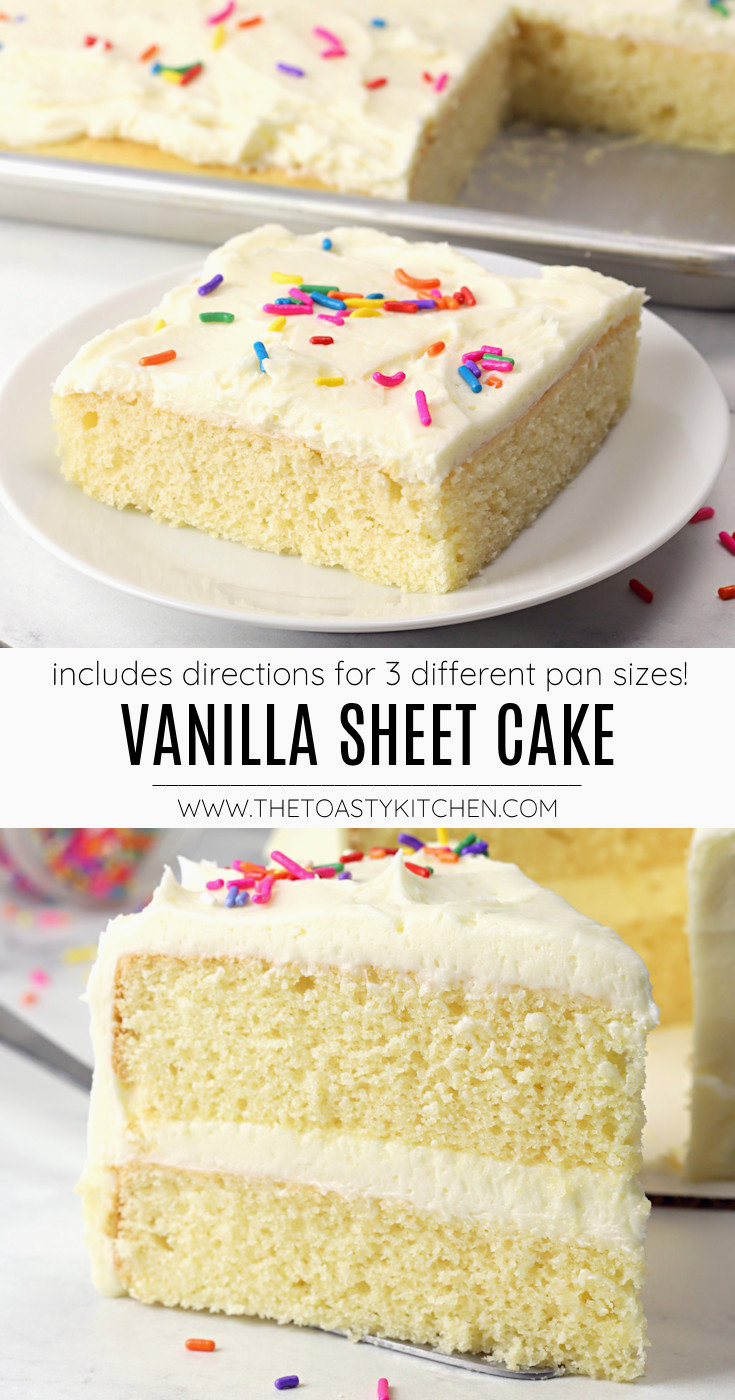
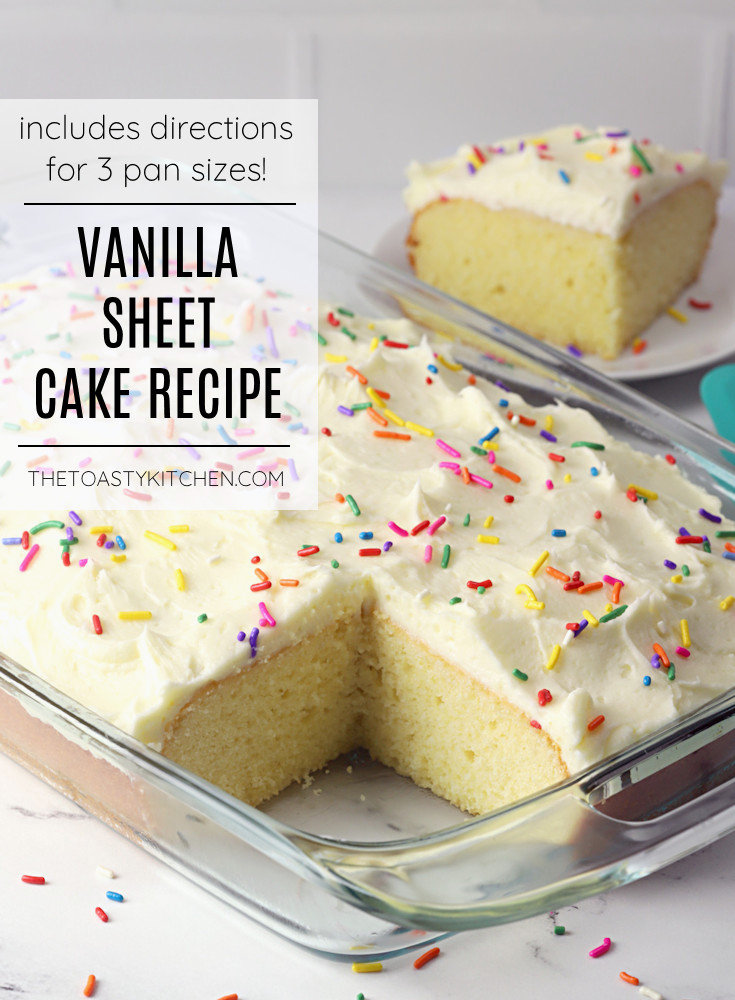
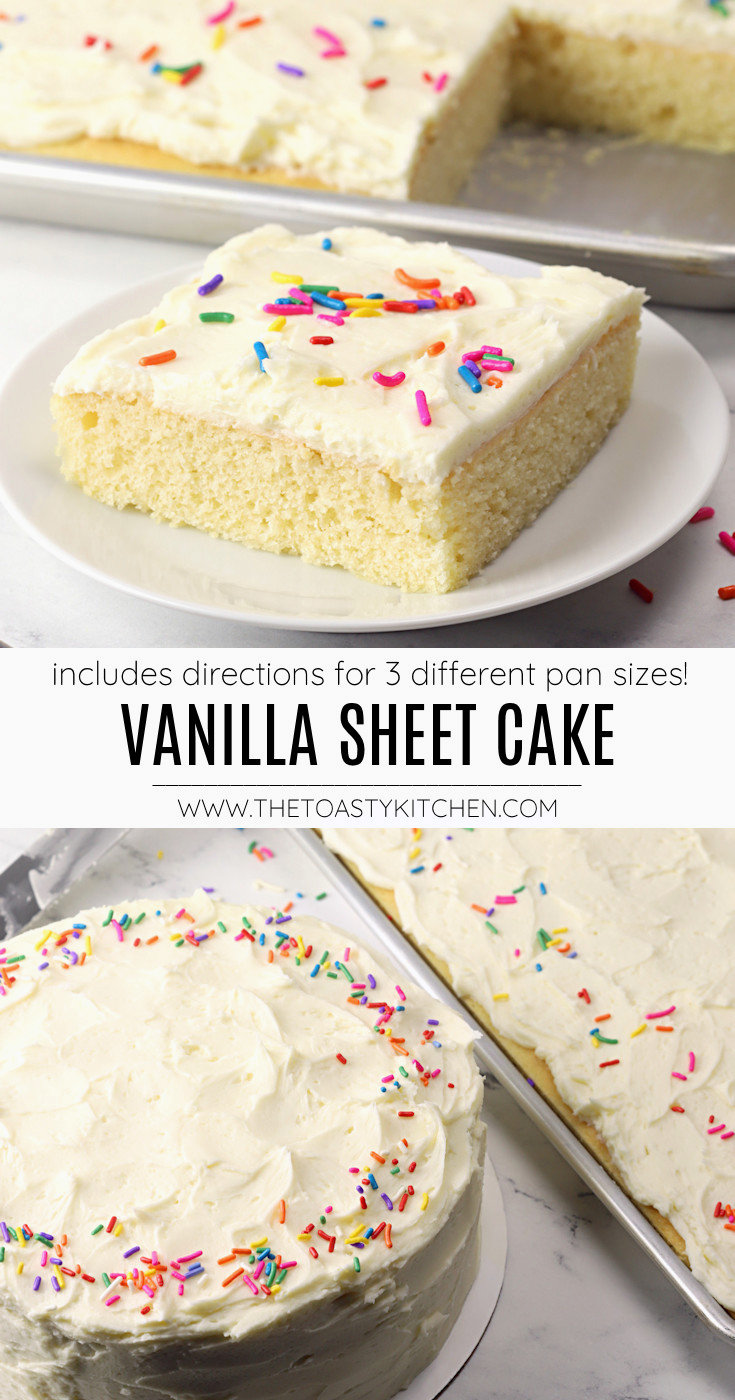
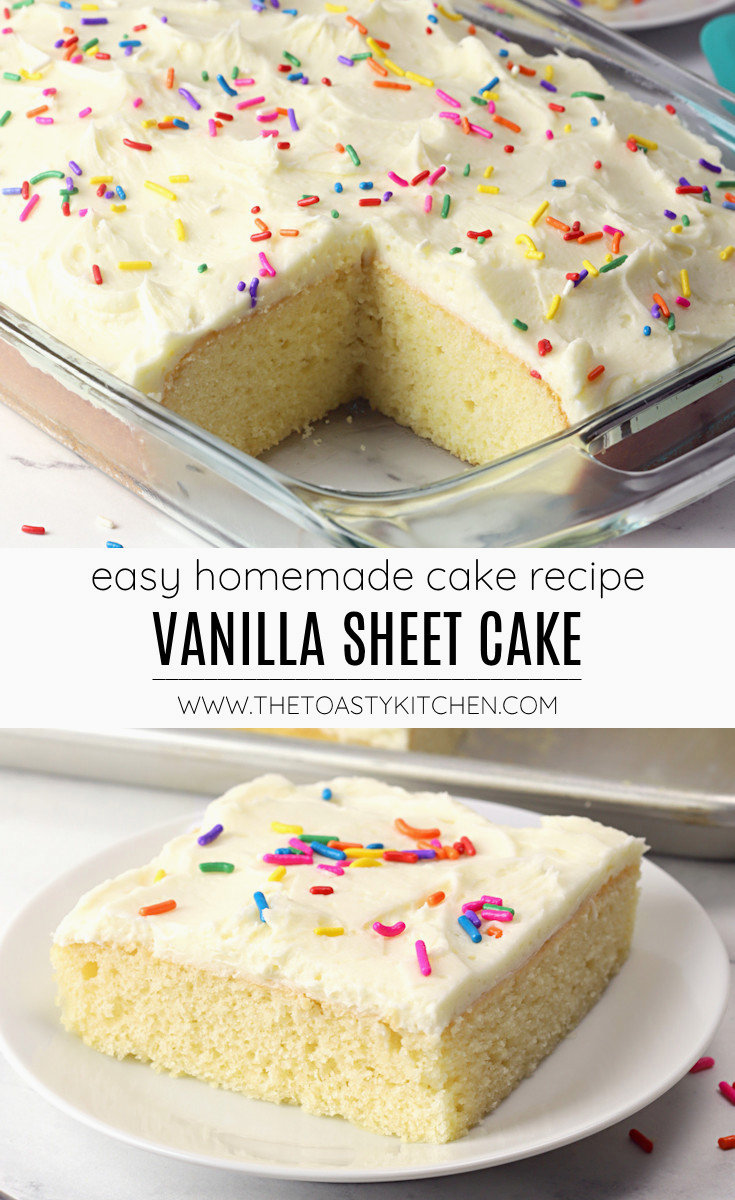
Vanilla sheet cake is a classic yellow cake recipe that's tender, fluffy, and easy to make at home. Topped with my favorite whipped buttercream frosting, this recipe can be made in three different pan sizes - even as a layer cake! It makes the perfect classic birthday cake.
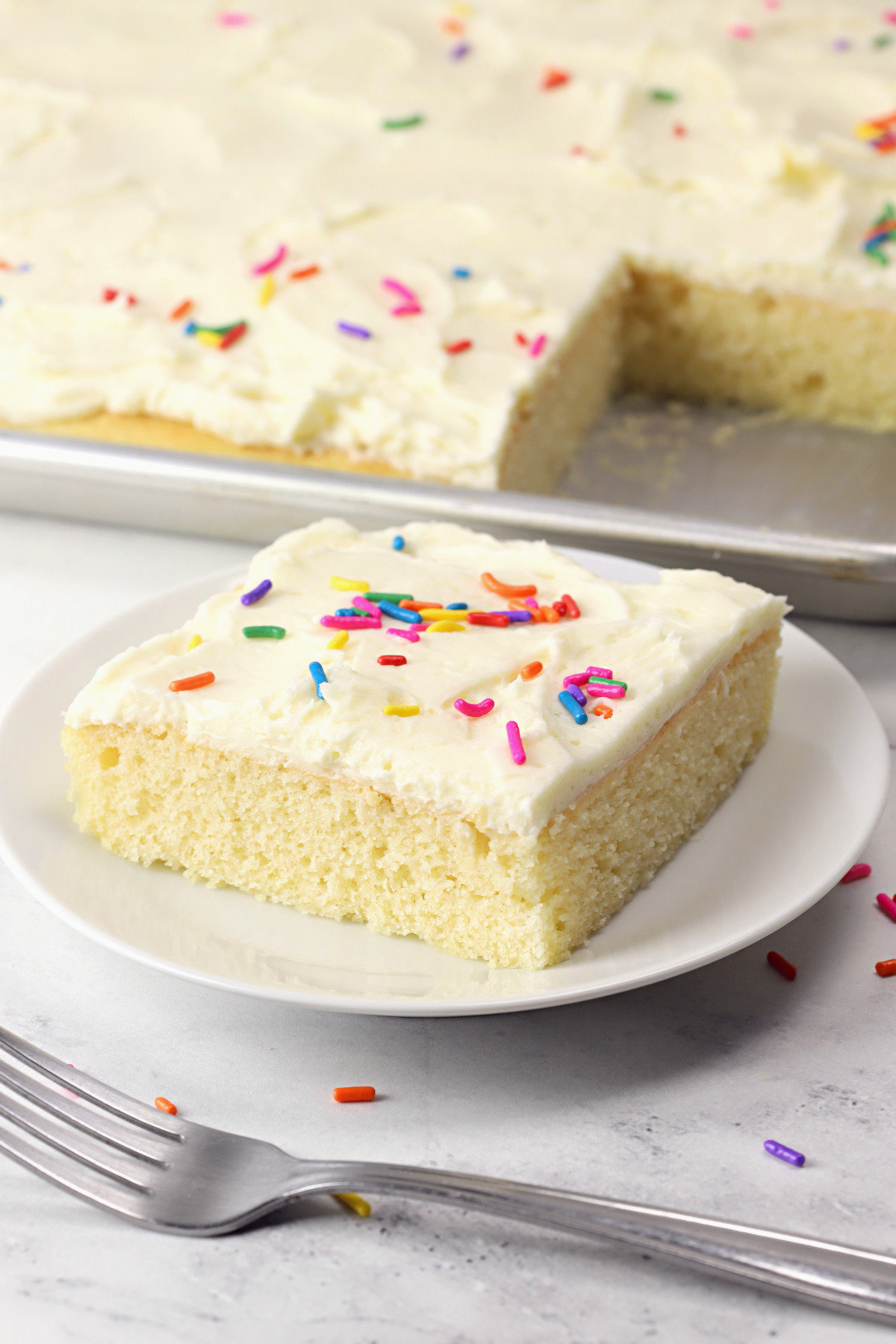
After many reader requests, I have finally turned my vanilla cupcake recipe into a full-sized cake! This cake recipe is perfect for birthdays and celebrations, and is made with simple ingredients.
This cake can be made, as written, in three pan sizes. Make this cake in a 9x13 sheet pan, 13x18 sheet pan, or as a 9-inch two layer cake! Instructions for each are included in the recipe card.
This vanilla cake turns out moist, fluffy, and tender. The whipped buttercream frosting is reader favorite recipe - it's easy to make and has a classic sweet vanilla flavor!
Make this vanilla sheet cake for your next birthday party, celebration, or family gathering. It's perfect for any time of year.
What size pan to use
This recipe works as written in three different sizes:
- 9x13 baking pan (with 2 inch tall sides)
- Two 9-inch round cake pans
- 13x18 half sheet pan (with 1 inch sides)

So, what size do you choose? This is totally up to personal preference. I have tested this recipe in all three sizes (as shown above) and they all turn out tender, moist, and delicious.
Both the 9x13 and 13x18 sheet cakes can remain in the pan after baking. Simply frost, slice, and serve! Round cakes need to be removed from their pans, trimmed, assembled, and frosted. This will take extra skill, patience, and frosting (which I'll go over later).
Suggested baking pans:
- Nordic Ware Classic Metal 9x13 Covered Cake Pan
- Natural Aluminum Nordic Ware Commercial Baker's Half Sheet (2 Pack)
- Nordic Ware 9" Round Natural Aluminum Cake Pans (2 Pack)
Metal vs. glass baking pans
Did you know that there is a difference in baking with metal versus baking with glass?
Metal, like aluminum, is a conductor, meaning it heats up quickly and allows heat to pass through easily. This bakes your cake evenly and quickly. Metal pans are also basically indestructible!
Glass is an insulator, meaning it takes longer to heat up, but will stay hot for longer. Baking a cake in glass can take longer than baking in a metal pan, which often translates into overcooked edges while waiting for the center to finish.
The benefit of glass is that you can see your cake while it bakes, ensuring the edges don't burn. It's also visually pleasing to serve a cake in a glass pan.
While I did bake my 9x13 cake in a glass pan for these photos, I recommend using an aluminum pan instead. Metal is easier to work with overall, and your cake is more likely to bake evenly throughout.
Here's a great article with more details: Bon Appetit - Is It Better to Bake in Glass or Metal?
Ingredients and substitutions
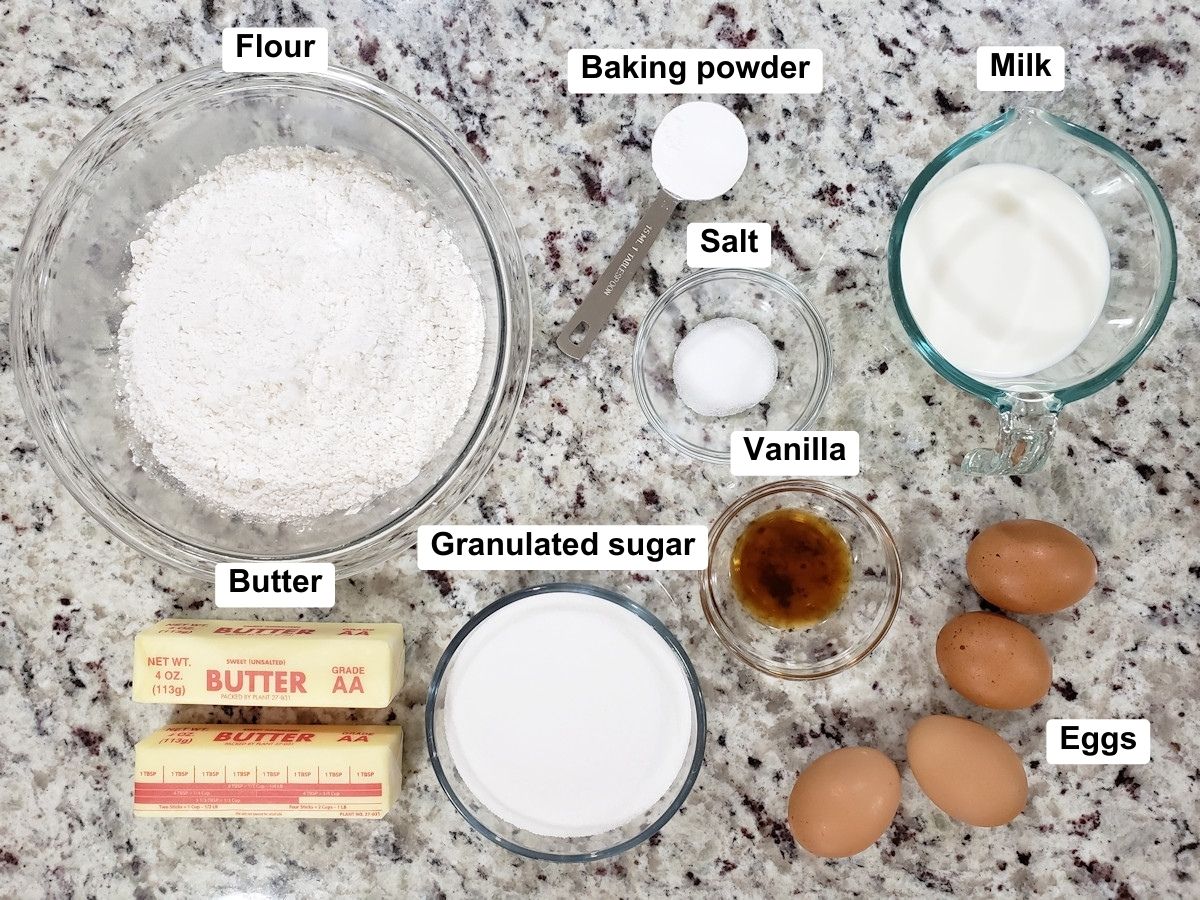
Since baking is an exact science, I do not recommend substituting any ingredients in this recipe. If you do not have the listed ingredients on hand, I recommend searching for a recipe that does include those ingredients.
Unsalted butter and salt can be substituted with salted butter if needed.
I do not suggest substituting cake flour with all purpose flour. Cake flour gives your cake a tighter crumb and tender texture. When substituting with all purpose flour in my cupcake recipe, readers often complained of a 'cornbread' type texture - this is why.
Baking powder is needed for this recipe, not baking soda. These two are not interchangeable.
Butter, eggs, milk, and granulated sugar add moisture to your cake, and should not be substituted. This can change the texture and make your cake dry.
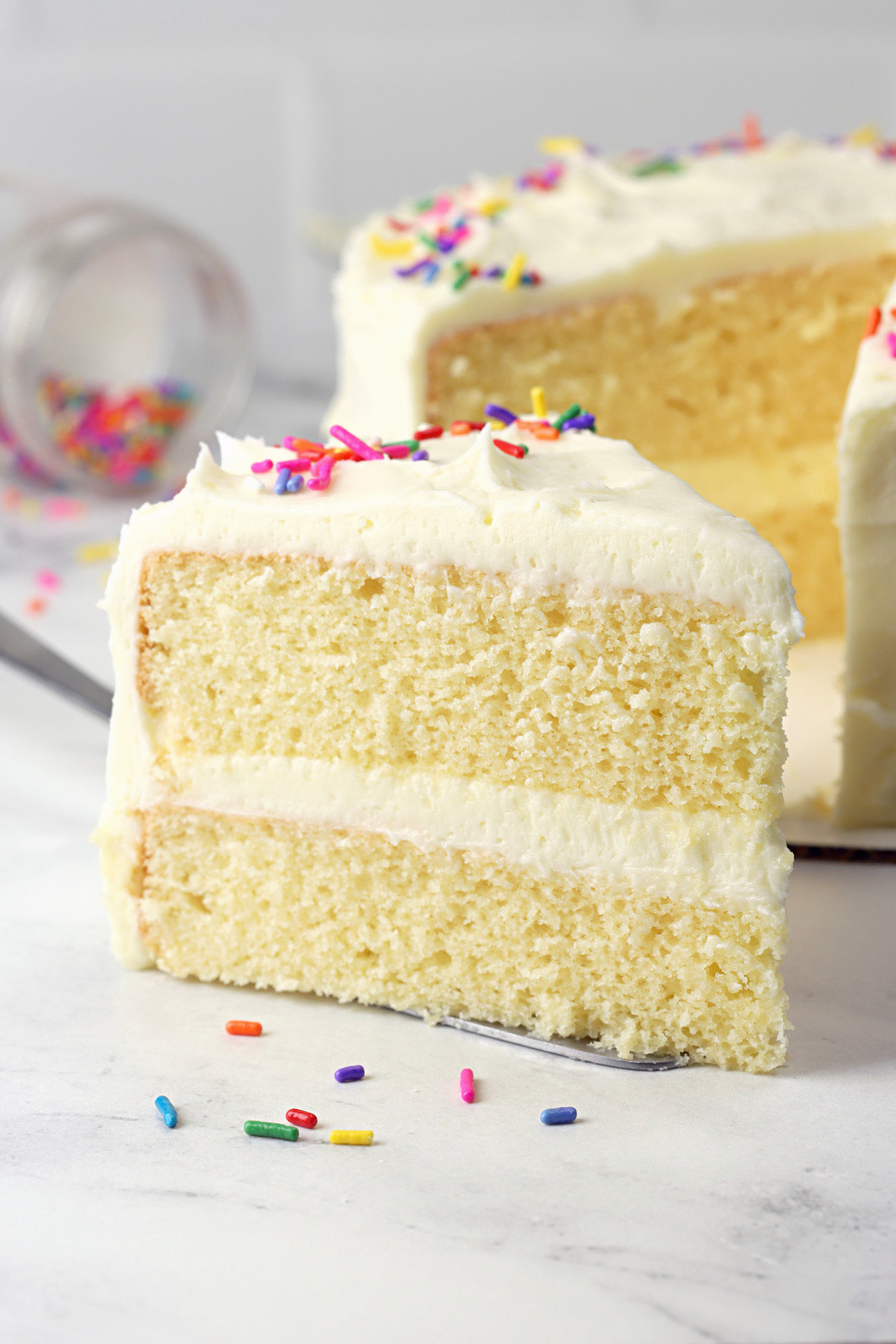
Cake batter tips and tricks
- Make sure your butter, eggs, and milk are all room temperature before beginning (not melted, not cold). Room temperature ingredients emulsify when mixed and create a creamy, even batter that bakes up fluffy in the oven.
- Sift or whisk your dry ingredients together. This removes clumps and helps make a smooth, even batter.
- Mix your dry ingredients just enough to incorporate them into the batter. Overmixing can overwork the gluten, causing your cake to turn out tough.
- I recommend using a hand mixer on medium speed for creaming together your butter, sugar, and eggs. Then, switch to low speed for adding the dry ingredients and milk.
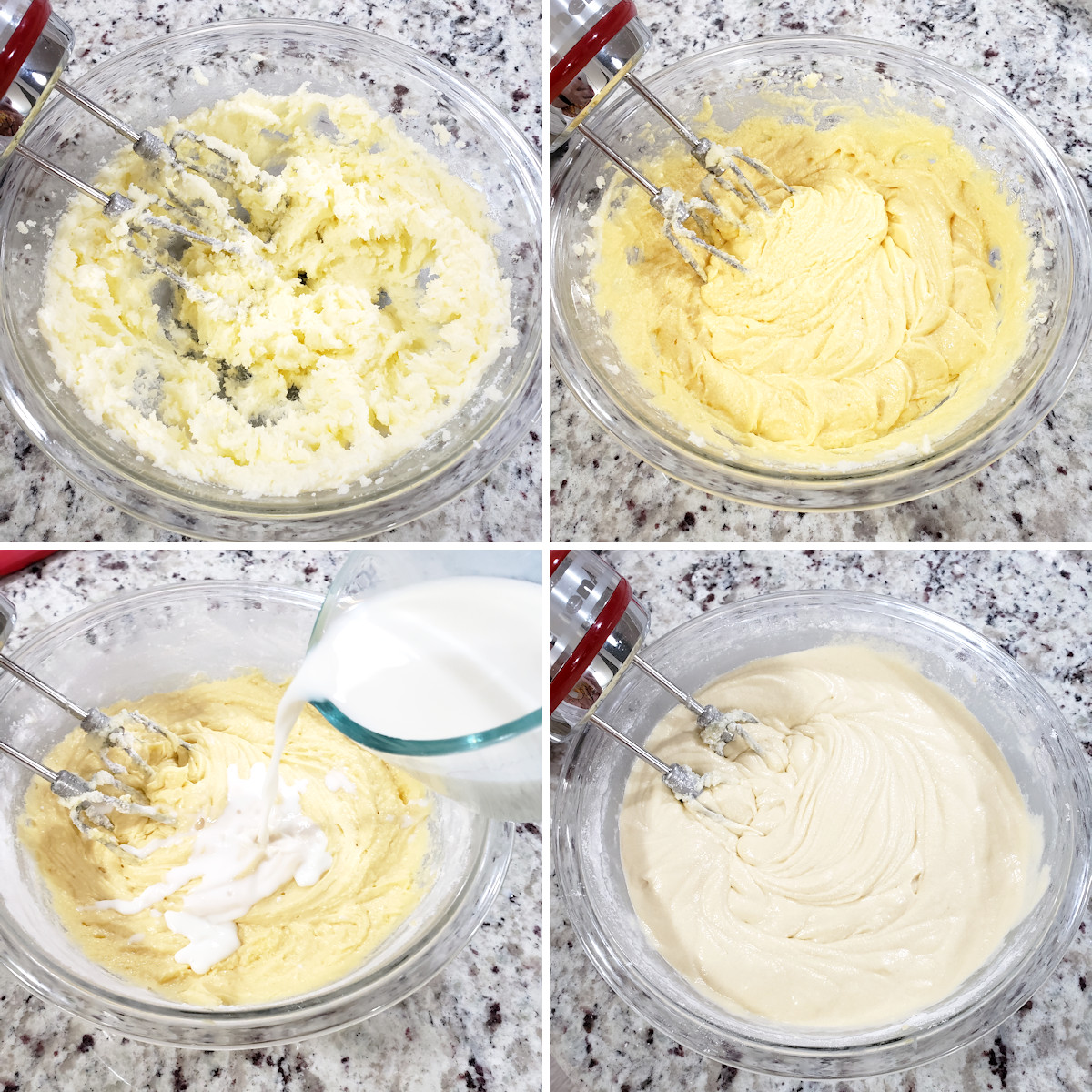
Frosting your cake
I've included my recipe below for whipped buttercream frosting, which is a reader favorite. It's fluffier than traditional buttercream, but still sweet. You could also use a traditional American buttercream, chocolate buttercream, or whipped cream.
As written, this frosting recipe will frost your 9x13 cake, 13x18 cake, or the middle and top of your layer cake (leaving the sides unfrosted). To fully frost a layer cake, make an additional ½ batch of frosting for the sides.
Your frosting layer will be thicker on the 9x13 cake and thinner on the 13x18 cake. Proportionally, the frosting thickness will always match the cake thickness.
If you'd like to add extra decorations (like piped rosettes), you'll need extra frosting.
Do not frost a warm cake! Buttercream frosting melts around 90 degrees. Adding frosting to a hot cake will cause it to melt. Wait until your cake is completely cooled.
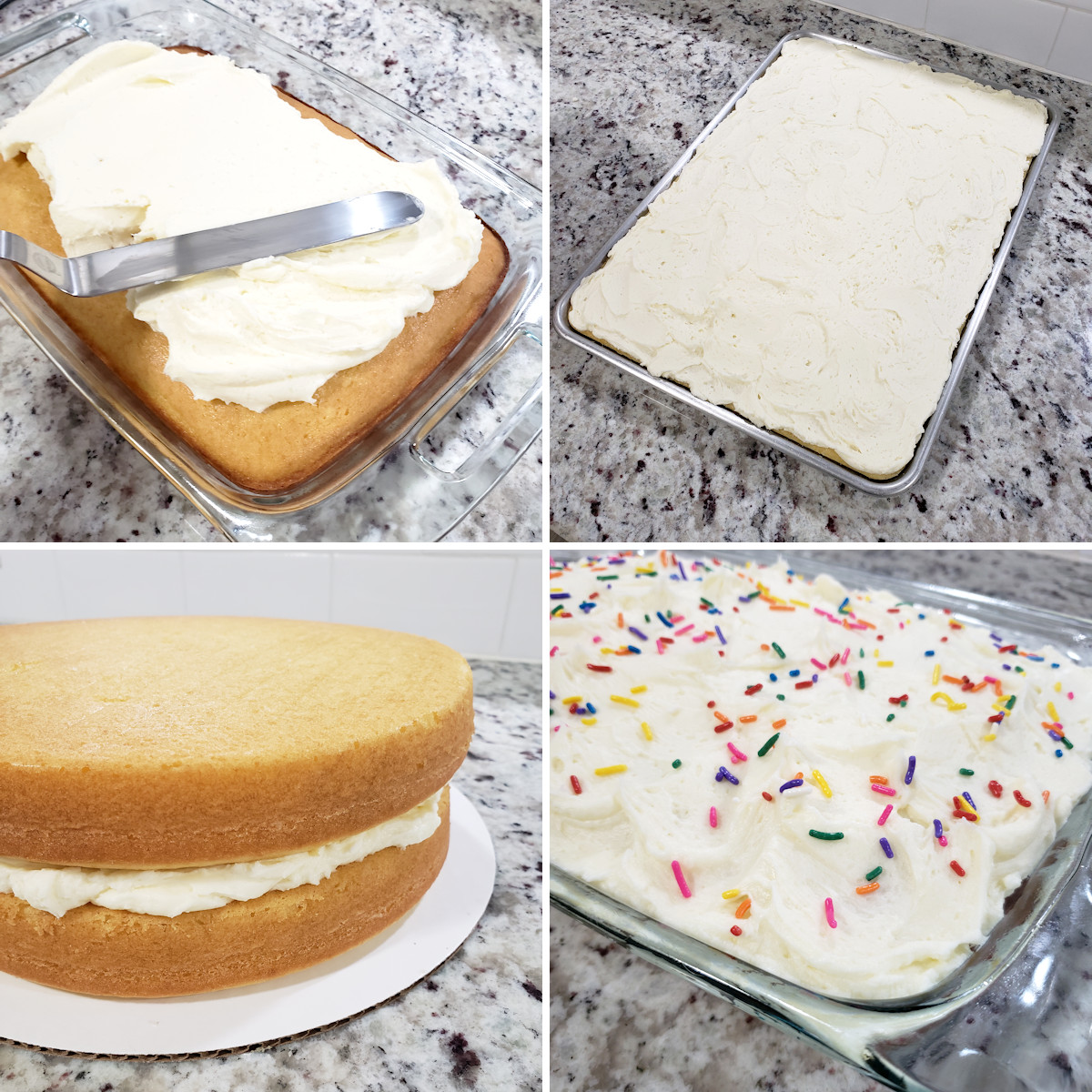
Cake storage
Homemade cakes are best served the same day they are baked. However, there are solutions if you need to make your cake a few days (or weeks) ahead of time.
Room temperature - Frosted cake can be stored in a tightly sealed container at room temperature for up to two days, but will begin to dry out over time. Cake is best served the same day once frosted. If your home is nearing 90 degrees Fahrenheit or hotter, I recommend storing in the refrigerator instead.
Refrigerated - Unfrosted or frosted cake can be refrigerated for 2 to 3 days. Wrap unfrosted cake in plastic and store in a sealed container. Optionally, brush your cake with simple syrup to help keep it moist for longer (see my section below on how to prevent dry cake). Bring to room temperature for an hour before serving.
Frozen - Unfrosted or frosted cake can be frozen for up to two months. For a frosted cake, first freeze for an hour, unwrapped, until firm. Gently wrap in plastic and store in a tightly sealed container for up to 2 months. Thaw your cake in the refrigerator overnight, then bring it to room temperature for an hour before serving.
Buttercream frosting can also be frozen in a tightly sealed container for 2 to 3 months. Thaw overnight in the refrigerator, then bring to room temperature before rewhipping again to make it light and fluffy.
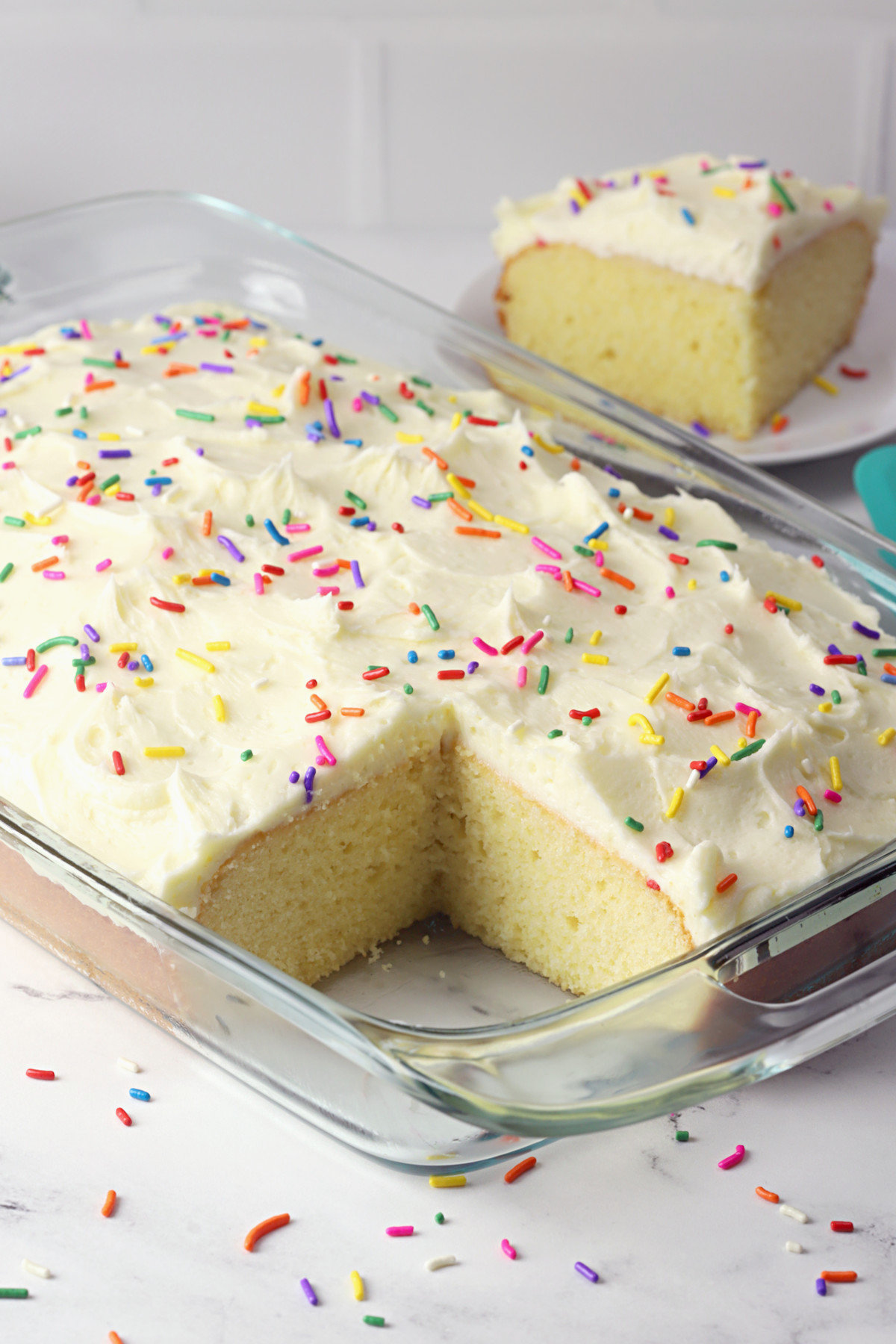
How to prevent a dry cake
No one wants to go through the steps of baking a cake only for it to turn out dry! These are my favorite tips for ensuring your cake bakes up moist and tender.
- Do not substitute any ingredients. The fats and sugar (butter, whole milk, granulated sugar, and eggs) in this recipe help keep your cake moist. Substituting those ingredients will change the texture and moisture in your cake.
- Properly measure your flour. Too much flour can cause your cake to turn out dry. Either use a kitchen scale to weigh your flour (this is what I do and recommend), or spoon the flour into your measuring cup and level off with a knife. Scooping with the measuring cup directly from a bin of flour compacts it into the cup, adding up to 25% extra flour to the recipe.
- Do not overbake your cake. If you haven't substituted ingredients, the only other reason your cake will turn out dry is from overbaking.
- Watch your cake, not the time. Ovens are inconsistent and can run hotter or colder than the next oven. The time that worked for me may not work for you. Start checking your cake 5 minutes early for doneness.
- If your oven bakes unevenly, rotate your cake pan(s) halfway through baking.
- Three easy ways to check for doneness: 1. Does your cake jiggle a lot when you move the pan? It's not done yet. 2. Gently press on the top of the cake with your finger. If the cake pops back up immediately, it's done. If an indentation is left, your cake needs more time. 3. Poke a toothpick into the center of your cake - if it comes out clean or with dry crumbs, your cake is done.
- Use an aluminum pan instead of glass. Glass is an insulator, which means it takes longer to heat up in the oven, taking longer to bake your cake. This can cause the edges to dry out while waiting for the center to finish baking. While this is not always the case, I suggest using metal for the most consistent results (especially for beginner bakers).
- This is a baker's secret (optional, but effective!) - brush simple syrup over your cake before frosting. A layer of simple syrup helps keep the cake moist for longer. Simple syrup is a 1:1 ratio of water and granulated sugar, brought to a boil on the stove top until dissolved, then cooled to room temperature. I'd suggest about ¼ cup or more for this size cake.
Vanilla Sheet Cake
Topped with my favorite whipped buttercream frosting, this recipe can be made in three different pan sizes - even as a layer cake! It makes the perfect classic birthday cake.
Servings: 16 or more servings
Calories: 524 kcal
Vanilla cake
- 1 cup unsalted butter room temperature
- 1 ¾ cups granulated sugar
- 1 tablespoon vanilla extract
- 4 large eggs room temperature
- 3 cups cake flour
- 1 tablespoon baking powder
- ¾ teaspoon salt
- 1 cup whole milk room temperature
Whipped Buttercream Frosting
- 1 cup unsalted butter room temperature
- 4 cups confectioner's sugar
- ⅓ cup heavy cream
- 2 teaspoons vanilla extract
- ⅛ teaspoon salt
Vanilla Cake
-
Preheat oven to 350 degrees Fahrenheit. Generously grease a 9x13 or 13x18 inch baking pan and set aside. Or, grease and flour two 9-inch round cake pans and set aside.
-
In a large bowl, add room temperature butter and granulated sugar. Beat until creamed and fluffy. Add vanilla and eggs, one at a time, mixing until incorporated and smooth.
-
In a separate bowl, sift together dry ingredients: cake flour, baking powder, and salt. Add half of the dry ingredients to butter mixture. Mix until just combined. Add half of milk, again mixing until just combined. Repeat once more to add remaining dry ingredients and milk.
-
Pour batter into prepared baking sheet (or evenly between two round cake pans) and spread into an even layer.
-
9x13 baking pan: 32-38 minutes
13x18 half sheet pan: 18-20 minutes
Two 9 inch round cake pans: 26-30 minutes
Two 8 inch round cake pans: 28-34 minutes
Bake your cake for the time listed above, or until cake is baked through in the center and a toothpick comes out clean. Ovens can run hot, so I suggest checking your cake for doneness 5 minutes early.
-
Remove cake from oven and allow to cool completely in the pan(s) on a wire cooling rack.
Frosting
-
*As written, frosting will cover a 9x13 cake, 13x18 cake, or the middle and top of a 2-layer cake (with bare sides). To frost the sides, make an additional ½ batch of frosting.
-
In a large bowl, add room temperature butter and beat until creamy. Add confectioner's sugar and slowly mix until ingredients are fully combined. Then, whip at high speed for 2-3 minutes, or until light and fluffy.
-
Add heavy cream, vanilla extract, and salt. Whip for an additional 3-4 minutes, or until light and fluffy. Add additional heavy cream as needed to reach desired consistency.
-
For a sheet cake: Spread frosting in an even layer onto cooled cake. Optionally, add sprinkles before frosting crusts.
For a layer cake: Gently flip and remove cakes from their pans. Trim the rounded tops with a serrated knife to make flat layers. Place one layer onto a cake stand or plate. Top with frosting in an even layer. Add second layer of cake and top with another layer of frosting. Spread remaining frosting onto the sides of the cake.
-
Slice and serve!
- Sheet cake can be sliced to serve up to 24 guests.
- Baking is an exact science. I do not recommend substituting any ingredients. The butter, milk, eggs, and sugar keep your cake moist - substituting any of these ingredients with a lower fat alternative can change the texture and make your cake dry.
- Unfrosted or frosted cake will keep in a sealed container at room temperature for 2 days, in the refrigerator for 2-3 days, or frozen for up to 2 months. If refrigerating or freezing unfrosted cake layers, wrap tightly in plastic and place in a tightly sealed container. Thaw overnight in the refrigerator, then bring to room temperature for an hour before serving.
Calories: 524 kcal | Carbohydrates: 67 g | Protein: 5 g | Fat: 27 g | Saturated Fat: 16 g | Trans Fat: 1 g | Cholesterol: 110 mg | Sodium: 156 mg | Potassium: 148 mg | Fiber: 1 g | Sugar: 49 g | Vitamin A: 867 IU | Vitamin C: 1 mg | Calcium: 70 mg | Iron: 1 mg
More recipes
-
Homemade Vanilla Cupcakes
-
Whipped Buttercream Frosting
-
Lemon Sheet Cake
-
Easy White Cupcakes
Source: https://thetoastykitchen.com/vanilla-sheet-cake/
0 Response to "Easy to Draw Piece of Vinella Cake"
Postar um comentário